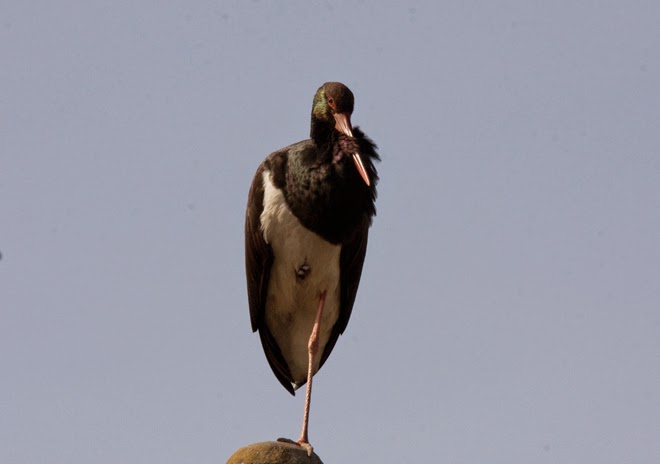One of two Black storks at Isahaya Bay, January 2015.
Oriental White Stork is another species that disappeared but even more dramatically as it was formerly a widespread breeding species. It still occurs, usually in winter but it's rare and could turn up anywhere in the country. I've seen two in Kansai over the years, a wandering immature which by chance stumbled upon the Hyogo re-introduction programme headquarters and stopped wandering. And another, a Chinese ringed bird, which settled for the winter at Kameoka, just outside Kyoto city. This bird seemed to become a source of civic pride among the local dog-walkers and farmers.
Video-grab of the Chinese-ringed Oriental White Stork soon after arrival, November 2004, Kameoka.
Now that birds from the re-introduction scheme based at Toyoka (Hyogo prefecture) are successfully breeding in the wild it is possible to run into these birds in rural Hyogo and Kyoto in any season, though you'd still need to be very lucky. Or indeed, even further afield as birds from this scheme have wandered the length and breadth of Honshu and as far as Hokkaido and Kyushu.
The Crested Ibis re-introduction project on Sado Island is more recent and as yet smaller scale but at least one bird has turned up in Ishikawa, an area in which they hung on until late in the day, there may be hope for this species re-occupying its former range too.
Eurasian and Black-faced Spoonbills both occur in Japan in winter. Though Black-faced is more numerous overall, it's Eurasian that's more frequent in Kansai. However numbers are very low and it's impossible to guess when or where they might turn up. Ponds around northern Lake Biwa have a good track record of hosting wintering birds and I've seen a number there over the years.
Adult Eurasian with its dipped-in-custard bill on a pond near Lake Biwa.
Black-faced Spoonbill will be of more interest to most overseas visitors but fewer come as far east as Kansai and visting birders who have the time will expect to see this species in Kyushu where it is quite easy to find at certain locations, particularly estuaries in the north and north west.
An immature Black-faced on the Yodo River in Osaka city was a good local record.
A party of Black-faced Spoonbills, Kyushu.
Eurasian and Black-faced together in Kyushu.
Almost synchronised spooners.
Immature Black-faced Spoonbill in Kyushu, December 2015.












No comments:
Post a Comment